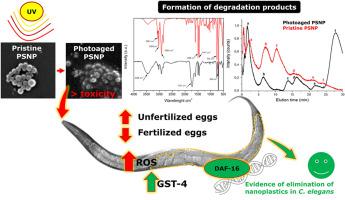当前位置:
X-MOL 学术
›
Environ. Pollut.
›
论文详情
Our official English website, www.x-mol.net, welcomes your feedback! (Note: you will need to create a separate account there.)
Photoaged polystyrene nanoplastics exposure results in reproductive toxicity due to oxidative damage in Caenorhabditis elegans
Environmental Pollution ( IF 8.9 ) Pub Date : 2024-03-18 , DOI: 10.1016/j.envpol.2024.123816 Rocío Errázuriz León , Vicente André Araya Salcedo , Francisco Javier Novoa San Miguel , Cynthia Rosa Andrea Llanquinao Tardio , Adolfo Andrés Tobar Briceño , Stefano Francesco Cherubini Fouilloux , Marcela Barbosa de Matos , Cesar Saldías , Walter Ruggeri Waldman , Christian Espinosa-Bustos , Maria Fernanda Hornos Carneiro
Environmental Pollution ( IF 8.9 ) Pub Date : 2024-03-18 , DOI: 10.1016/j.envpol.2024.123816 Rocío Errázuriz León , Vicente André Araya Salcedo , Francisco Javier Novoa San Miguel , Cynthia Rosa Andrea Llanquinao Tardio , Adolfo Andrés Tobar Briceño , Stefano Francesco Cherubini Fouilloux , Marcela Barbosa de Matos , Cesar Saldías , Walter Ruggeri Waldman , Christian Espinosa-Bustos , Maria Fernanda Hornos Carneiro

|
The increase of plastic production together with the incipient reuse/recycling system has resulted in massive discards into the environment. This has facilitated the formation of micro- and nanoplastics (MNPs) which poses major risk for environmental health. Although some studies have investigated the effects of pristine MNPs on reproductive health, the effects of weathered MNPs have been poorly investigated. Here we show in that exposure to photoaged polystyrene nanoplastics (PSNP-UV) results in worse reproductive performance than pristine PSNP (i.e., embryonic/larval lethality plus a decrease in the brood size, accompanied by a high number of unfertilized eggs), besides it affects size and locomotion behavior. Those effects were potentially generated by reactive products formed during UV-irradiation, since we found higher levels of reactive oxygen species and increased expression of GST-4 in worms exposed to PSNP-UV. Those results are supported by physical-chemical characterization analyses which indicate significant formation of oxidative degradation products from PSNP under UV-C irradiation. Our study also demonstrates that PSNP accumulate predominantly in the gastrointestinal tract of (with no accumulation in the gonads), being completely eliminated at 96 h post-exposure. We complemented the toxicological analysis of PSNP/PSNP-UV by showing that the activation of the stress response via DAF-16 is dependent of the nanoplastics accumulation. Our data suggest that exposure to the wild PSNP, i.e., polystyrene nanoplastics more similar to those actually found in the environment, results in more important reprotoxic effects. This is associated with the presence of degradation products formed during UV-C irradiation and their interaction with biological targets.
中文翻译:

光老化聚苯乙烯纳米塑料暴露会导致秀丽隐杆线虫因氧化损伤而产生生殖毒性
塑料产量的增加以及新兴的再利用/回收系统导致大量废弃物进入环境。这促进了微塑料和纳米塑料(MNP)的形成,对环境健康构成了重大风险。尽管一些研究调查了原始 MNP 对生殖健康的影响,但对风化 MNP 的影响的研究却很少。在这里,我们表明,暴露于光老化聚苯乙烯纳米塑料 (PSNP-UV) 会导致比原始 PSNP 更差的繁殖性能(即胚胎/幼虫致死率加上雏鸟尺寸减小,并伴有大量未受精卵)。影响大小和运动行为。这些效应可能是由紫外线照射过程中形成的反应产物产生的,因为我们发现暴露于 PSNP-UV 的蠕虫体内活性氧水平较高,GST-4 表达增加。这些结果得到了物理化学表征分析的支持,该分析表明 PSNP 在 UV-C 照射下明显形成了氧化降解产物。我们的研究还表明,PSNP 主要积聚在胃肠道中(性腺中没有积聚),并在暴露后 96 小时完全消除。我们通过表明 DAF-16 应激反应的激活依赖于纳米塑料的积累来补充 PSNP/PSNP-UV 的毒理学分析。我们的数据表明,暴露于野生PSNP(即与环境中实际发现的聚苯乙烯纳米塑料更相似)会导致更重要的生殖毒性效应。这与 UV-C 照射期间形成的降解产物的存在及其与生物靶标的相互作用有关。
更新日期:2024-03-18
中文翻译:

光老化聚苯乙烯纳米塑料暴露会导致秀丽隐杆线虫因氧化损伤而产生生殖毒性
塑料产量的增加以及新兴的再利用/回收系统导致大量废弃物进入环境。这促进了微塑料和纳米塑料(MNP)的形成,对环境健康构成了重大风险。尽管一些研究调查了原始 MNP 对生殖健康的影响,但对风化 MNP 的影响的研究却很少。在这里,我们表明,暴露于光老化聚苯乙烯纳米塑料 (PSNP-UV) 会导致比原始 PSNP 更差的繁殖性能(即胚胎/幼虫致死率加上雏鸟尺寸减小,并伴有大量未受精卵)。影响大小和运动行为。这些效应可能是由紫外线照射过程中形成的反应产物产生的,因为我们发现暴露于 PSNP-UV 的蠕虫体内活性氧水平较高,GST-4 表达增加。这些结果得到了物理化学表征分析的支持,该分析表明 PSNP 在 UV-C 照射下明显形成了氧化降解产物。我们的研究还表明,PSNP 主要积聚在胃肠道中(性腺中没有积聚),并在暴露后 96 小时完全消除。我们通过表明 DAF-16 应激反应的激活依赖于纳米塑料的积累来补充 PSNP/PSNP-UV 的毒理学分析。我们的数据表明,暴露于野生PSNP(即与环境中实际发现的聚苯乙烯纳米塑料更相似)会导致更重要的生殖毒性效应。这与 UV-C 照射期间形成的降解产物的存在及其与生物靶标的相互作用有关。



























 京公网安备 11010802027423号
京公网安备 11010802027423号